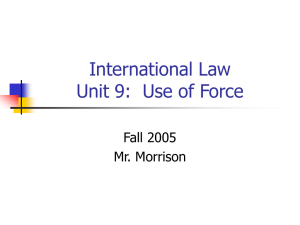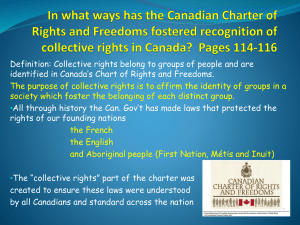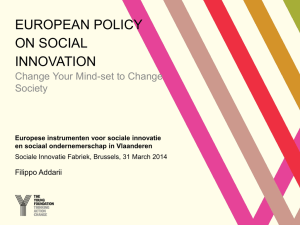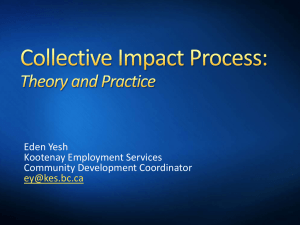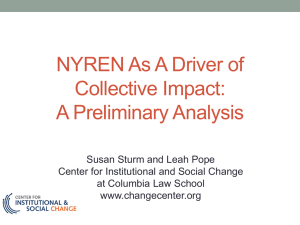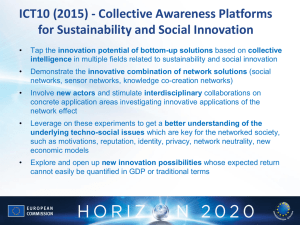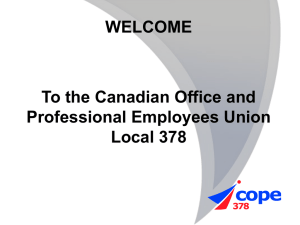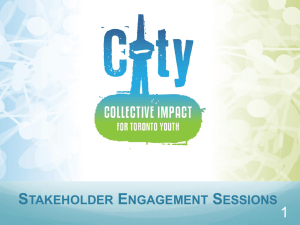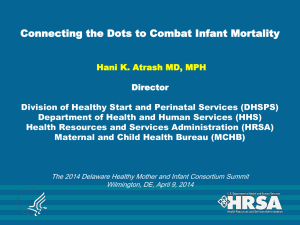Session 3E - Collective Impact
advertisement
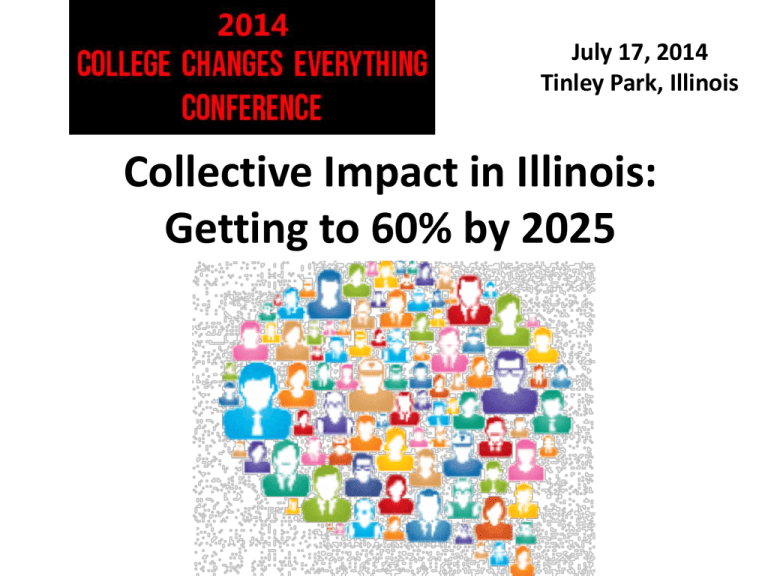
July 17, 2014 Tinley Park, Illinois Collective Impact in Illinois: Getting to 60% by 2025 Presenters • Teresa Ramos, Outreach Director, Advance Illinois – tramos@advanceillinois.org • Dani Craft, Director of Operations & Community Engagement, Education Coalition of Macon County Foundation of Macon County – dcraft@edco4kids.org • Sarah Bjelland, Data & Research Manager, Education Coalition of Macon County – sbjelland@edco4kids.org • Sam Nelson, Director of Outreach Development, Illinois Student Assistance Commission – sam.nelson@isac.illinois.gov Collective Impact: The Beginning • Since the 2011 Stanford Social Innovation Review article introduced the concept, collective impact has been widely adopted as an effective way to address complex social and environmental challenges. • Collective impact has proven to be a powerful approach in tackling a wide range of issues in communities all over the world. • Collective Impact vs. Isolated Impact Stanford Social Innovation Review • “Collective Impact” – by John Kania & Mark Kramer, Winter 2011 http://www.ssireview.org/articles/entry/colle ctive_impact • “Channeling Change: Making Collective Impact Work” – by Fay Hanleybrown, John Kania, & Mark Kramer, 2012 http://www.ssireview.org/blog/entry/channel ing_change_making_collective_impact_work Stanford Social Innovation Review • “Embracing Emergence: How Collective Impact Address Complexity” – John Kania & Mark Kramer – Jan. 21, 2013 SSIR Blog http://www.ssireview.org/blog/entry/embrac ing_emergence_how_collective_impact_addr esses_complexity Isolated Impact Collective Impact Collective Impact Condition #1 Collective Impact Condition #2 Collective Impact Condition #3 Collective Impact Condition #4 Collective Impact Condition #5 Collective Impact Forum • Online community where practitioners, policymakers, funders, and business can share success stories and challenges, solve problems, and learn from each other. • FSG, Aspen Institute Forum for Community Solutions, Forum for Youth Investment (Ready by 21), United Way Worldwide, and more… • http://collectiveimpactforum.org/ StriveTogether • A cradle to career vision for education – StriveTogether’s Student Roadmap to Success plots the course of a student’s journey from cradle to career. • Map is not just a guide for the student, but for all members of the community with an interest in seeing that students have successful journeys. • If they are not at these critical points, we know the potential for long-term success is greatly inhibited. StriveTogether continued • It highlights specific research-based competencies and experiences, as well as key transition points where we must ensure students are on target developmentally. • StriveTogether Cradle to Career Network is comprised of 49 partnerships. • http://www.strivetogether.org/ National College Access Network (NCAN) • Based on research and best practices of its 350-plus members, NCAN developed a recommended set of Common Measures to help college access and success programs guide and assess their work. • https://dl.dropboxusercontent.com/u/582451 40/Common%20Measures/Common%20Meas ures%202-page%20handout%2010-2-12.pdf Gates Foundation Community Partnerships • The OMG Center for Collaborative Learning published a series of Issue Briefs highlighting lessons from the Bill & Melinda Gates Foundation's Community Partnerships portfolio evaluation. • The Issue Briefs share results of investments and tangible examples of how communities approached the goal of improving postsecondary completion. Gates Continued • Issue Brief 1: Building Commitment to a Postsecondary Systems Change Agenda – focuses on how the partnerships built public awareness, deepened relationships with partner organizations, and engaged community leaders to implement their initiatives. • Issue Brief 2: Using Data to Advance a Postsecondary Systems Change Agenda – focuses on how the partnerships used data to build public commitment, set priorities for policy and practice changes, and monitor the partnership’s internal structures and processes. Gates continued • Issue Brief 3: Aligning Policies and Practices to Advance a Postsecondary Systems Change Agenda – focuses on how communities can adopt and implement policies and practices to increase postsecondary success. • Issue Brief 4: Building and Sustaining Partnerships to Advance a Postsecondary Systems Change Agenda – on how communities can successfully strengthen partnerships to increase postsecondary success. Gates continued • Issue Brief 5: Amplifying Learning in Systems Change Investments: An Experience in Developmental Evaluation – focuses on how communities, funders, and evaluators can conduct effective developmental evaluations to help advance postsecondary systems change. • All Issue Briefs available at: http://www.omgcenter.org/knowledge_center/is suebriefs/the_community_partnerships_issue_br iefs_series Illinois Examples • Education Coalition of Macon County – Community Improvement through Education http://www.edco4kids.org/ • Alignment Rockford – Supporting our Public Schools http://www.edco4kids.org/ • Achieve Quad Cities – creating a thriving community by engaging all Quad Citians in lifelong learning http://www.achieveqc.org/



